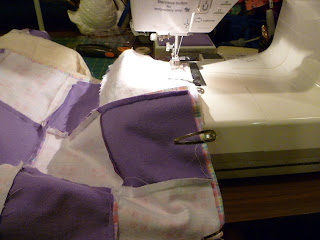
Sew each solid strip to each plaid strip. When finished, you will have 5 larger strips, half solid, half plaid.
Iron each seam, making the underseams go under the darker fabric.
Trim any uneven edges.
Flip every other strip so it makes a square, with the solids opposite each other.
Sew these 4 square pieces together.
Sew 4 of these new units together in a row.
Like this.
Iron the seams down.
Sew the long units together and iron each seam. Make sure the solid and the plaid alternate. You may have to remove one 2 piece unit on the end of the last long strip, and sew it to the other end of the strip to make the alternates come out right. (This is where I tell you I didn't plan this quilt top, I just found the fabrics in my stash and started cutting).
Lay out a piece of batting (to make it flatter and take out wrinkles, pop it in the dryer for a few minutes on high).
Lay the backing fabric on top of the batting, RIGHT SIDE UP. (I forgot to take pictures of this step, and ended up taking a spare piece of the backing and placing it on the already cut batting - which is why it appears out of proportion and doesn't match the photo below).
Lay the pieced top on the backing fabric, WRONG SIDE UP. Cut all the way around the "sandwich" matching edges on all three fabrics. (You can see this is the other side of the batting, I remembered the camera about then).
Using hair clips (available in bulk in the sewing section of most stores), clip all the way around the edges of the 3 fabric "sandwich."
Start sewing in the middle of one side around the edge. Sew the other three sides, then come around and sew the fourth side, but leave an 8 inch gap between where you started and where you end. This technique is called "birthing" a quilt because you will be pulling the inside out, later in the instructions.
Clip the corners.
Reach inside the gap and grab some fabric. Pull the quilt through the gap, turning it right side out. Using a pointed tool, place your hand and the tool inside the quilt and poke each of the 4 corners out until they're squared. (The below is a flat bamboo turning point tool, available at any store with a sewing center). You can also use a pencil, or some other pokey looking instrument, except don't use scissors, they tend to tear through the fabric, causing all kinds of anguish and re-sewing.
Iron the edges of the quilt, matching the seams as best you can.
Iron the seams at the gap towards the inside. Use the quilt clips to keep the gap sandwich together.
Starting at the gap, top-stich around the edge of the entire quilt. This will help keep the quilt from sagging at the edges.
On the top of the quilt, using the seams as your guide, "stitch-in-the-ditch" each parallel and horizontal seam from top to bottom. When finished, each single square on the quilt should be quilted around the edges. Check the back to make sure you didn't miss any.
The finished quilt.
I hope you enjoyed this first tutorial. If you get lost, feel free to leave a comment and I'll answer.






















